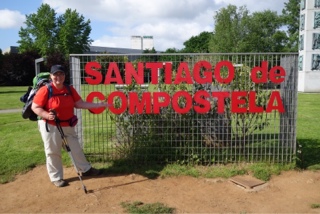On Friday, May 15th, after more than 40 days of walking, we finally made it to Santiago de Compostela. It was a dramatic entry - mostly because the last pedestrian bridge into the city - next to a major artery - (after descending the "Mount of Joy") is over a huge 6 lane highway. As we were walking over, a semi truck drove by and the gust of wind it left in its wake literally blew the hat off my head! Luckily, I was able to catch it before it flew down onto the traffic below.
The Roman Catholic Church considers the cathedral in Santiago to be the end of the Camino. We made our way there and to the official pilgrim office to receive our certificate of completion, known as a 'compostela'. You must present your pilgrim credential, which has been stamped along the way, to prove you have walked. There is a form you fill in which asks for your name, country and reason for walking. The options include religious, spiritual, sport, cultural, etc. Before you know it, you are presented with the compostela (free, suggested donation 1-2€) and offered a traveling tube to protect the paperwork (2€). Then, of course, you exit through the cathedral gift shop.
There are also pilgrim masses offered each day at noon and 7:30pm in the cathedral. We went to the evening one. It was kind of amazing to see just how many people were packed into the giant church - standing room only. I should say: we knew before coming that the pilgrimage is a 'Catholic thing'. We Presbyterians have been treated well and welcomed into churches along the way. But we are definitely aware of our Protestant identity in some new ways. Parts of this final service felt worshipful: the nun teaching us all songs to sing for the service & the homily about how the Camino is a vision of Christian community we should take home with us. But once again, we were sad the table isn't open to everyone. It felt like a disconnect to go from hearing from a priest about the whole of Christian community to witnessing communion served only for the Roman Catholics, and the cup only for the priests.
Also, we just can't get used to the over-the-top silver and gold baroque decor in many Spanish churches, especially in the cathedrals. We appreciate the art, and the support artists have received from the church. However, it's hard not to think of how else the church could have used the money spent on precious metals and jewels. And the image of St. James the "matamoros" or "Moor slayer" riding high on a white steed, sword drawn, is just not one I want to see - especially at the front of a place of worship. There is a legend in Spain that James (long dead) came back to help the Christians reclaim the Iberian peninsula from the Moors. While we are sure this was a great way to rally the troops (I mean who wouldn't want a saint and apostle on your side?) we both have some issues with portraying a martyred apostle as a killer and glorifying this aspect of the story above what we know of his actual life. Especially when this violent depiction is physically much larger than any image of Christ at the front of the worship space.
During the mass we also got to see the famous botafumierio in action. This is the thurible, a container in which incense is burned. The Santiago cathedral is known for having one of the largest ones - some theorize it was large in medieval days to help with the stench of unbathed pilgrims. It is swung over the worshippers at the beginning or end of the mass. While the priest reminded us that this was an object used for worship, for many it was clearly more like a bit of theater: watching the team of monks pull on ropes to make the giant silver object fly, smoking overhead, nearly touching the ceiling with each swing, iPhones and cameras snapping pictures and capturing video footage. (You can learn more here: http://www.catedraldesantiago.es/en/node/482
Or watch it in action on YouTube here: http://youtu.be/2QFd_55El1I)
For many pilgrims this is where the journey ends. They attend mass, hug a statue of the saint, pay respects to the silver box which supposedly contains his bodily remains, and receive a compostela. But for others the walk is not done. Those more in touch with the Celtic spirituality of the region than the Catholic faith continue on to the coast of Spain. That is what we have done.
We'll write more about that in other posts. As for Santiago, even though the Catholic rite wasn't as meaningful for us as it was for some, we still rejoiced at having made it to Santiago for the feast of the Ascension, and were grateful to sing along with other pilgrims in worship. We were happy to get our compostelas and visit with a few other pilgrims we had met along the way. But to be truthful, it didn't feel like the end for us. Partly this was due to the exclusion of believers to the table. Partly this was due to the abundance of gift/souvenir/junk shops & kiosks which give the area a VERY touristy feel. And part was probably just that we always hoped to walk on to the sea. So our first stop after Santiago was Finisterre. It was so named because until it was discovered that the Earth is round, it was thought to be the end of the world. So, we packed up (again) and walked on from the "end of the Camino" to the end of the world....









No comments:
Post a Comment